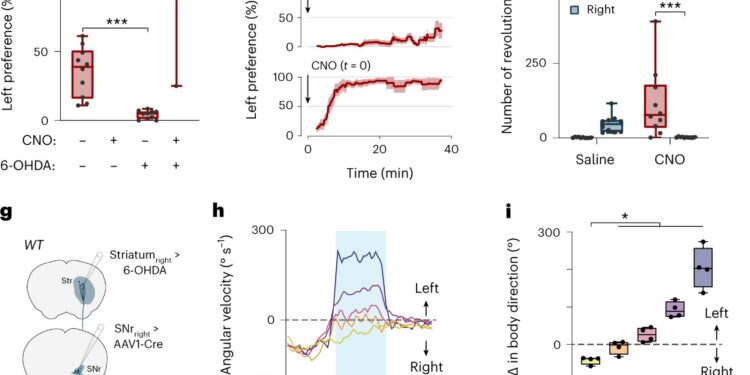Restoration of contraversive turning gaits in mice with acute unilateral striatal dopamine depletion. Credit: Natural neuroscience (2024). DOI: 10.1038/s41593-024-01569-8
Have you ever wondered what happens in the brain when we move to the right or left? Most people don’t; they just do it without thinking about it. But this simple movement is actually controlled by a complex process.
In a new study, researchers have discovered the missing piece in the complex nerve network needed for left-right turns. The discovery was made by a research team consisting of Assistant Professor Jared Cregg, Professor Ole Kiehn and their colleagues from the Department of Neuroscience at the University of Copenhagen.
In 2020, Ole Kiehn, Jared Cregg and their colleagues identified the “brain steering wheel,” a neural network located in the lower brainstem that controls left and right movements during walking. At the time, however, it was not clear how this right-left circuit was controlled by other parts of the brain, such as the basal ganglia.
“We discovered a new group of neurons in the brainstem that receive information directly from the basal ganglia and control the right-left circuit,” explains Ole Kiehn.
Ultimately, this discovery could help people suffering from Parkinson’s disease. The study was published in Natural neuroscience.
The basal ganglia are located deep in the brain. For many years, they have been known to play a key role in controlling voluntary movements.
Years ago, scientists discovered that stimulating the basal ganglia could influence right and left hand movements in mice. They just didn’t know how.
“When you walk, you will shorten the step length of the right leg before turning right and of the left leg before turning left. The newly discovered neural network is located in a part of the brainstem known as the PnO. They are the ones that receive signals from the basal ganglia and adjust the step length when we turn, and thus determine whether we move to the right or to the left,” explains Jared Cregg.
The study therefore provides a key to understanding how these absolutely essential movements are produced by the brain.
In the new study, researchers studied the brains of mice, because their brainstems closely resemble the human brainstem. Researchers therefore expect to find a similar right-left circuit in the human brain.
Parkinson’s disease is caused by a lack of dopamine in the brain. This affects the basal ganglia, and the researchers behind the new study believe this leads to a failure in activating the right-left brainstem circuit.
And this makes sense when you consider the symptoms experienced by people with advanced Parkinson’s disease: They often have difficulty turning when they walk.
In the new study, researchers investigated this in mice with symptoms resembling those of people with Parkinson’s disease. They created what is called the Parkinson’s disease model, removing dopamine from the mice’s brains and thus giving them motor symptoms similar to those experienced by people suffering from Parkinson’s disease.
“These mice had difficulty turning, but by stimulating the PnO neurons, we were able to alleviate these difficulties,” explains Jared Cregg.
Using deep brain stimulation, scientists could eventually develop similar stimulation for humans. Currently, however, they are unable to stimulate human brain cells as precisely as in mouse models, where they used advanced optogenetic techniques.
“Brainstem neurons are disordered and electrical stimulation, which is the type of stimulation used in human deep brain stimulation, cannot distinguish cells from one another. However, our knowledge of the brain continues to grow and “Eventually, we may be able to start considering targeted deep brain stimulation in humans,” concludes Ole Kiehn.
The researchers used optogenetics to stimulate the neural network of the PNO (pontine reticular nucleus, oral part). In short, optogenetics is a technique for genetically modifying specific brain cells to make them sensitive to light and therefore responsive to light stimulation.
When the researchers turned on the light, mice that were only able to turn left could now also walk in a straight line and turn right.
More information:
Jared M. Cregg et al, Basal ganglia and spinal cord pathway that controls locomotor gait asymmetries in mice, Natural neuroscience (2024). DOI: 10.1038/s41593-024-01569-8
Provided by the University of Copenhagen
Quote: Newly discovered brain cells play a key role in right and left turns (February 12, 2024) retrieved February 12, 2024 from
This document is subject to copyright. Apart from fair use for private study or research purposes, no part may be reproduced without written permission. The content is provided for information only.



